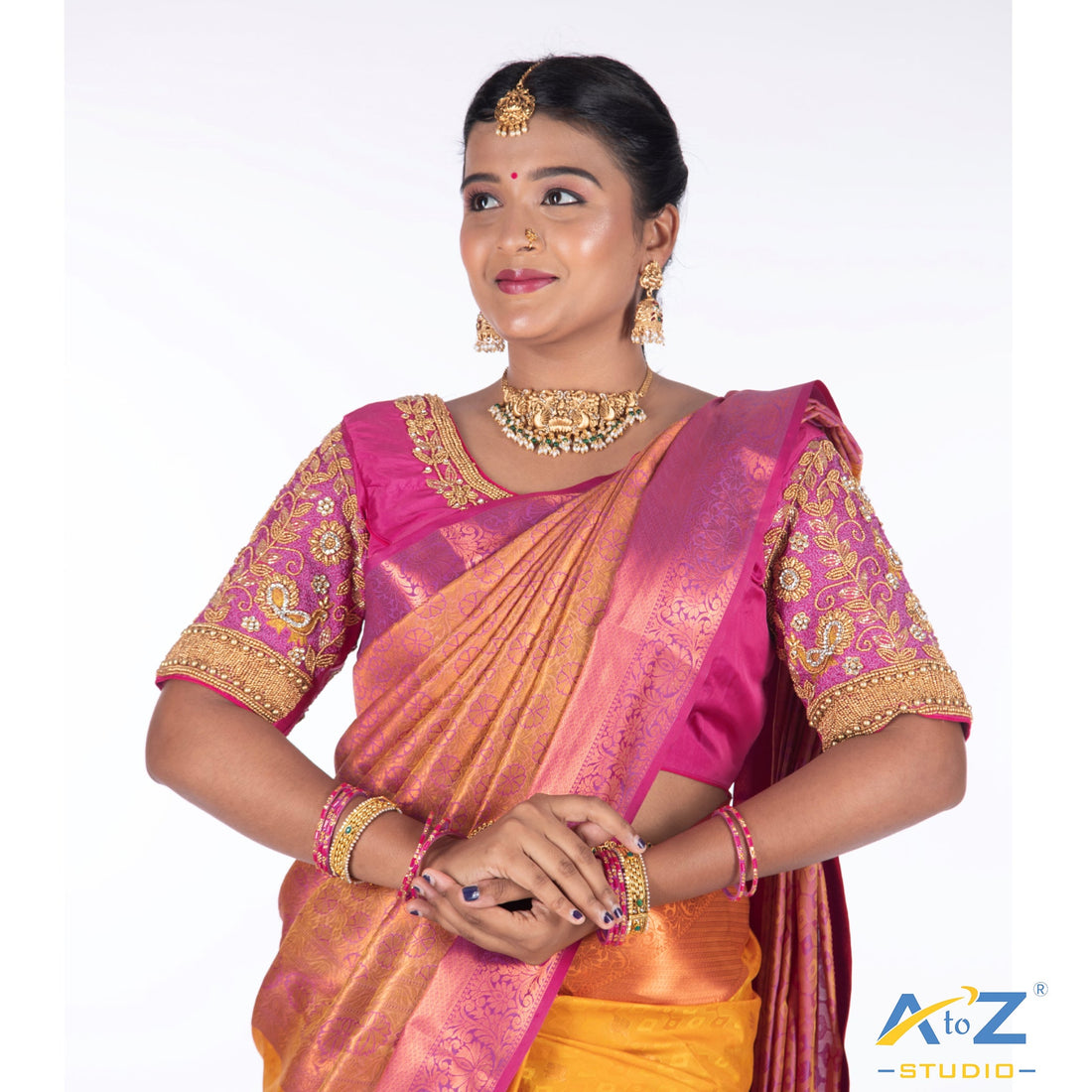
The Art of Layering: Dupatta Styling with Heavy Bridal Blouses
Share
A heavily embroidered bridal blouse is a work of art—but pairing it with the right dupatta drape can truly complete your look. When styled thoughtfully, the dupatta does more than cover—it frames your blouse, adds elegance, and lets every detail shine.
Whether you’re wearing a lehenga or a saree, learning the art of layering your dupatta ensures your blouse gets the attention it deserves without being overshadowed. Let’s dive into the most flattering, functional, and fashionable dupatta styles for heavy bridal blouses.
✨ Why Dupatta Styling Matters
-
Enhances the beauty of your blouse embroidery
-
Adds structure and flow to your bridal look
-
Balances weight and comfort during long ceremonies
-
Plays a huge role in your overall bridal silhouette and photos
🧵 Tips Before You Drape
-
If your blouse has heavy work on the sleeves or back, choose a transparent or sheer dupatta (like net or organza) to keep the design visible.
-
Avoid too many layers of heavy fabric — go light on the dupatta if the blouse is already ornate.
-
Think about your function: Certain styles are best for the wedding vs. the reception or pre-wedding events.
-
Plan your jewellery placement around your drape for a cohesive look.
💫 6 Dupatta Draping Styles That Complement Heavy Blouses
🕊️ 1. One-Side Shoulder Drape (Classic & Clean)
Let the dupatta fall elegantly over one shoulder, leaving the back of your blouse fully visible.
Perfect For: Blouses with heavily embroidered backs or tassels
Pair With: Low buns, statement earrings, and a second light dupatta around the waist if needed.
👑 2. V-Pinned Front Drape
The dupatta is pleated and pinned into a sharp "V" shape across the front while cascading behind, framing your neckline and sleeves.
Perfect For: Blouses with detailed sleeve embroidery or high necks
Bonus: It gives a regal, symmetrical finish—ideal for portraits.
🌸 3. Half-Saree Style Drape (South Indian Fusion Look)
Drape one end over the shoulder and pleat the other into your waist, mimicking a half-saree look while keeping the blouse center stage.
Perfect For: Traditional bridal blouses with Maggam or Zardosi work
Great With: Silk or raw silk dupattas in contrast tones
🪷 4. Back-Sling Drape (Minimalist & Modern)
The dupatta is draped lightly over both arms from behind—leaving the front and back of your blouse completely open.
Perfect For: Receptions or photo shoots
Blouse Match: Backless, sheer-back, or keyhole-back designs
🎀 5. Belted Dupatta Style (Structured & Trendy)
Place the dupatta over one or both shoulders, and secure it at the waist with a matching or embellished belt.
Perfect For: Blouses with mirror work or statement sleeves
Adds: A modern, cinched silhouette that’s both stylish and practical
✨ 6. Layered Double Dupatta Drape (Grand & Formal)
One light net dupatta draped over the head, and the second (heavier) dupatta pleated across the body or shoulder.
Perfect For: The main wedding ceremony
Why it works: Keeps the heavy blouse visible while respecting traditional head-drape customs.
💡 Dupatta Fabric Suggestions for Heavy Blouses
| Dupatta Fabric | Why It Works |
|---|---|
| Net | Sheer, light, doesn’t hide embroidery |
| Organza | Adds subtle structure and shine |
| Georgette | Flowy and easy to pleat |
| Tissue | Great for layering without adding bulk |
| Chiffon | Elegant and translucent; great for soft layering |
📸 Styling Tips for Picture-Perfect Dupatta Moments
-
Let the blouse back shine—opt for camera angles that highlight the embroidery.
-
Match dupatta borders with blouse elements (like zari, sequins, or tassels).
-
Coordinate your hairstyle with the drape (e.g., low bun with backless blouse and sheer dupatta).
-
Use brooches or pins to secure complex drapes stylishly.
💬 Final Word
A beautifully designed bridal blouse deserves to be seen—not hidden. Through strategic dupatta styling, you can elevate your entire bridal outfit, frame your finest embroidery, and feel confident in every pose.
Whether you're walking down the aisle or dancing through your reception, mastering the art of layering is your secret to turning tradition into trend.
